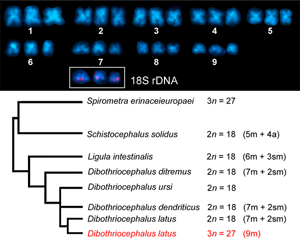Article contents
Molecular cytogenetic analysis of a triploid population of the human broad tapeworm, Dibothriocephalus latus (Diphyllobothriidea)
Published online by Cambridge University Press: 08 March 2021
Abstract

The large-sized tapeworm Dibothriocephalus latus is known as the broad or fish-borne cestode of mammals that is capable to infect humans and cause diphyllobothriosis. Recently, molecular data on D. latus has been accumulating in the literature and a complete genome sequence has been published; however, little is known about the karyotype and chromosome architecture. In this study, an in-depth karyological analysis of 2 D. latus specimens was carried out. The plerocercoids originated from a perch caught in subalpine Lake Iseo (Italy) and the tapeworms were reared in hamsters. Both specimens contained cells with a highly variable number of chromosomes ranging from18 to 27. Nevertheless, the largest portion of mitotic figures (47%) showed a number corresponding to the triploid set, 3n = 27. Accordingly, the karyotype of the analyzed specimens consisted of 9 triplets of metacentric chromosomes. Fluorescence in situ hybridization (FISH) with the 18S rDNA probe clearly demonstrated the presence of 3 clusters of hybridization signals on the triplet of chromosome 7, thus confirming the triploid status of the specimens. FISH with a telomeric (TTAGGG)n probe confined hybridization signals exclusively to the terminal chromosomal regions, supporting the earlier findings that this repetitive motif is a conserved feature of tapeworm telomeres.
- Type
- Research Article
- Information
- Copyright
- Copyright © The Author(s), 2021. Published by Cambridge University Press
Footnotes
Present address: Genomics Core Facility, European Molecular Biology Laboratory, Heidelberg, Germany.
References
- 7
- Cited by





